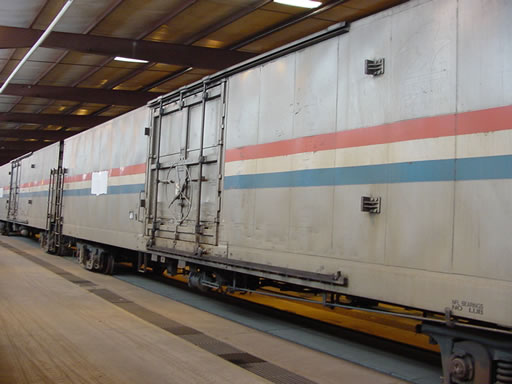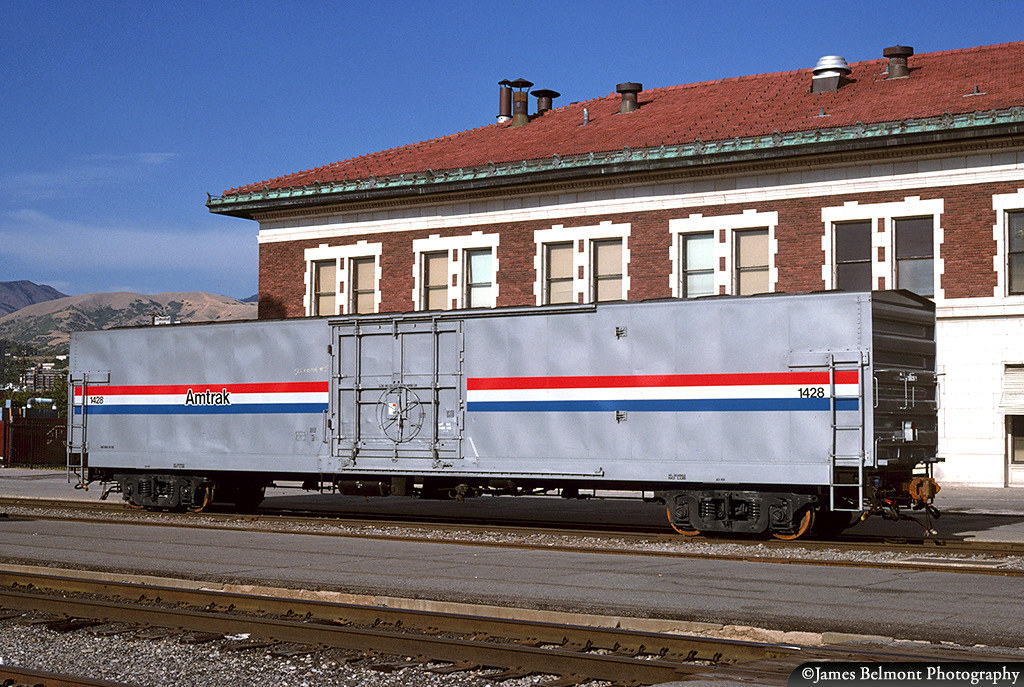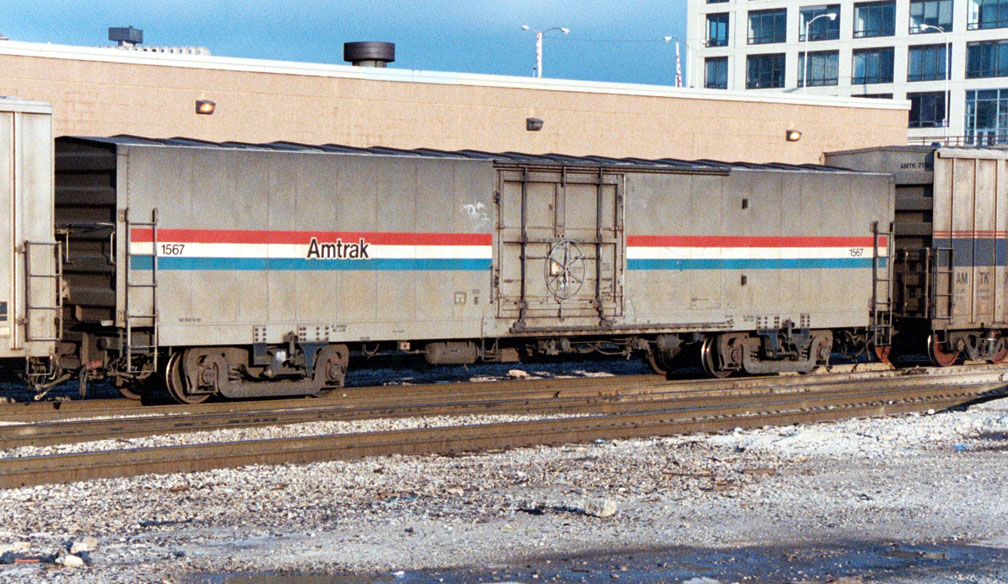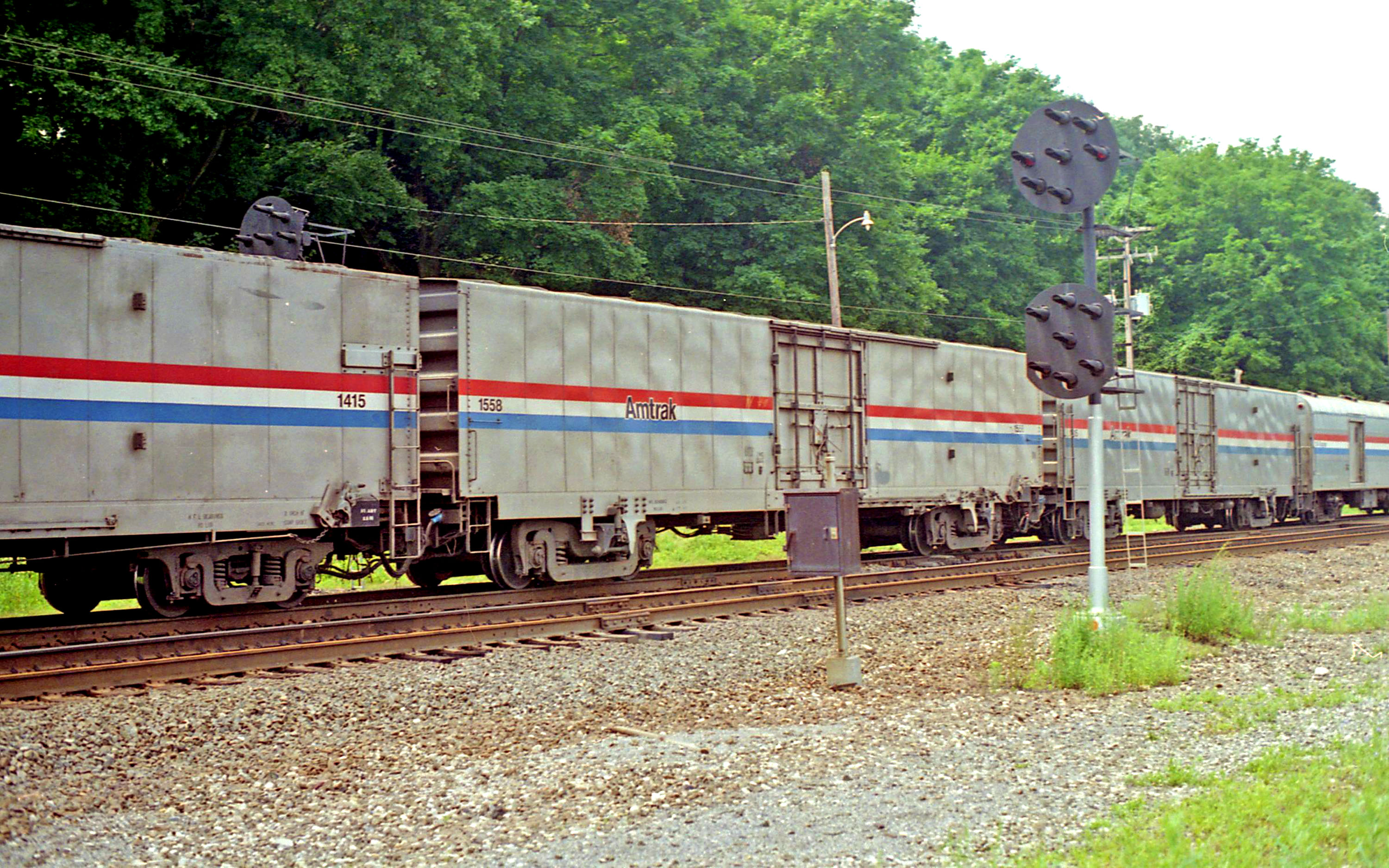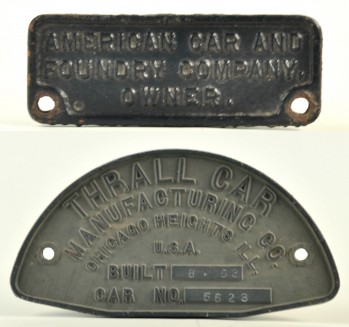History: Late in the 1980's, Amtrak's California Zephyr trains began to run new box cars called "material handling cars" The original 1400-series MHC-1 cars were built by Thrall in 1986 utilizing rebuilt trucks from former REA express cars with a short wheelbase.The MHC cars had pass-through cabling for HEP and usually operated on the head end of the train. The Southwest Chief usually had four or five daily. The MHCs were used primarily for handling bulk mail.
In 1989 Amtrak began receiving a second version of the MHC, the MHC-2, which carry road numbers in the 1500-series. These cars differed in some notable ways. The trucks were a new design that had a longer wheelbase than the earlier cars. Further, there was a body snubber anchor mounted on the sides of the car above each truck. These two details are the most obvious differences between the two car series, however the body and roof are entirely different from the earlier cars.
Unfortunately, the express-freight business indeed turned out to be a loser, particularly because Amtrak could not manage to complete the network expansion that it announced when it started handling the traffic. That resulted in the conventional boxcars, and later the ExpressTrak reefers, being parked in 2003.
Read more on UtahRails.com.
In 1989 Amtrak began receiving a second version of the MHC, the MHC-2, which carry road numbers in the 1500-series. These cars differed in some notable ways. The trucks were a new design that had a longer wheelbase than the earlier cars. Further, there was a body snubber anchor mounted on the sides of the car above each truck. These two details are the most obvious differences between the two car series, however the body and roof are entirely different from the earlier cars.
Unfortunately, the express-freight business indeed turned out to be a loser, particularly because Amtrak could not manage to complete the network expansion that it announced when it started handling the traffic. That resulted in the conventional boxcars, and later the ExpressTrak reefers, being parked in 2003.
Read more on UtahRails.com.
Railroad/Company: Thrall Car Manufacturing Company was a manufacturer of railroad freight cars in Chicago Heights, Illinois from 1917 to 2001. The company was sold to Trinity Industries in 2001. A.J. Thrall established the Union Wagon Company in 1916, selling used and reconditioned rail car components. This became the Thrall Car Manufacturing Company in 1917. By mid-century, under the leadership of Richard L. Duchossois, the company focused on building specialized freight cars, such as high-cube boxcars for auto parts, all-door boxcars for building products, gondolas, rotary-dump gondolas for coal, bulkhead flatcars and centerbeam flatcars for lumber, double-stack container cars, covered hoppers, autorack cars and single-level trailer cars. In the 1980s, Thrall acquired five competing railcar manufacturers, including autorack builders Whitehead & Kales and Portec, and became the largest such manufacturer of these cars in the United States. In 1984, Duchossois purchased the remaining shares of the company owned by the Thrall family, and the company then operated as part of Duchossois Industries. In the 1990s, Thrall had a production capacity of over 16,000 freight cars per year, with more than 3,000 employees.
From 1997, a European subsidiary Thrall Europa manufactured wagons in York, UK. Thrall Europa, York works closed 2002. In 2000, Thrall Europa acquired the railway vehicle manufacturer ČKD Vagonka Studénka (Czech Republic), renamed Thrall Vagonka Studénka. In 2006 Trinity Industries sold off its European operations to International Railway Systems. The closely held company was sold to Trinity Industries, based in Dallas, Texas, in 2001. The company was subsequently renamed Trinity Rail Group, LLC.
From Wikipedia
From 1997, a European subsidiary Thrall Europa manufactured wagons in York, UK. Thrall Europa, York works closed 2002. In 2000, Thrall Europa acquired the railway vehicle manufacturer ČKD Vagonka Studénka (Czech Republic), renamed Thrall Vagonka Studénka. In 2006 Trinity Industries sold off its European operations to International Railway Systems. The closely held company was sold to Trinity Industries, based in Dallas, Texas, in 2001. The company was subsequently renamed Trinity Rail Group, LLC.
From Wikipedia
Item Links: We found: 1 different collections associated with Rail - Rolling Stock (Freight) - 60 Foot Material Handling
- Collection N Scale Model Trains: 28 different items.
Item created by: gdm on 2018-02-19 16:25:40. Last edited by Alain LM on 2020-08-27 03:44:32
If you see errors or missing data in this entry, please feel free to log in and edit it. Anyone with a Gmail account can log in instantly.
If you see errors or missing data in this entry, please feel free to log in and edit it. Anyone with a Gmail account can log in instantly.


